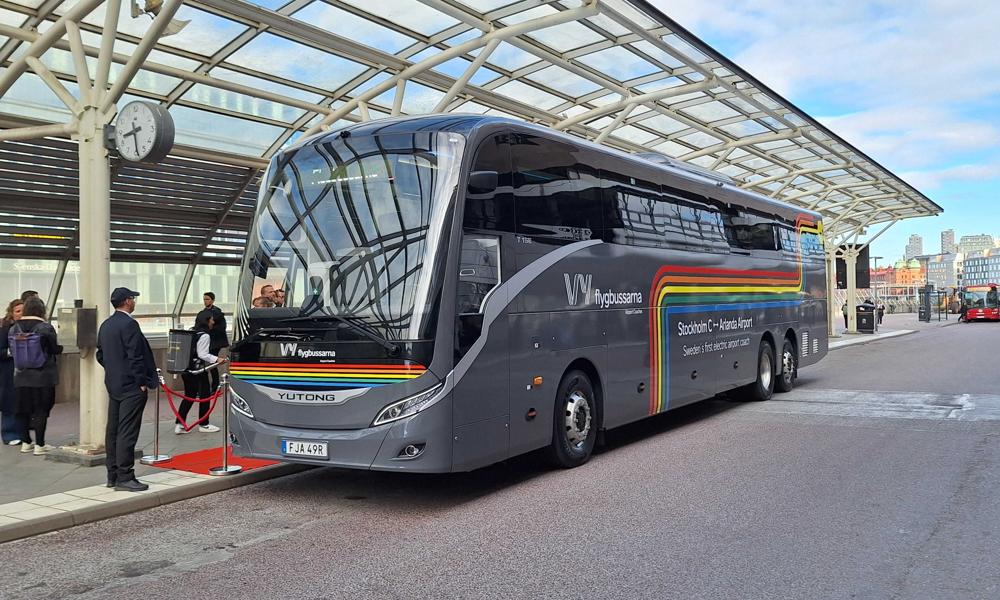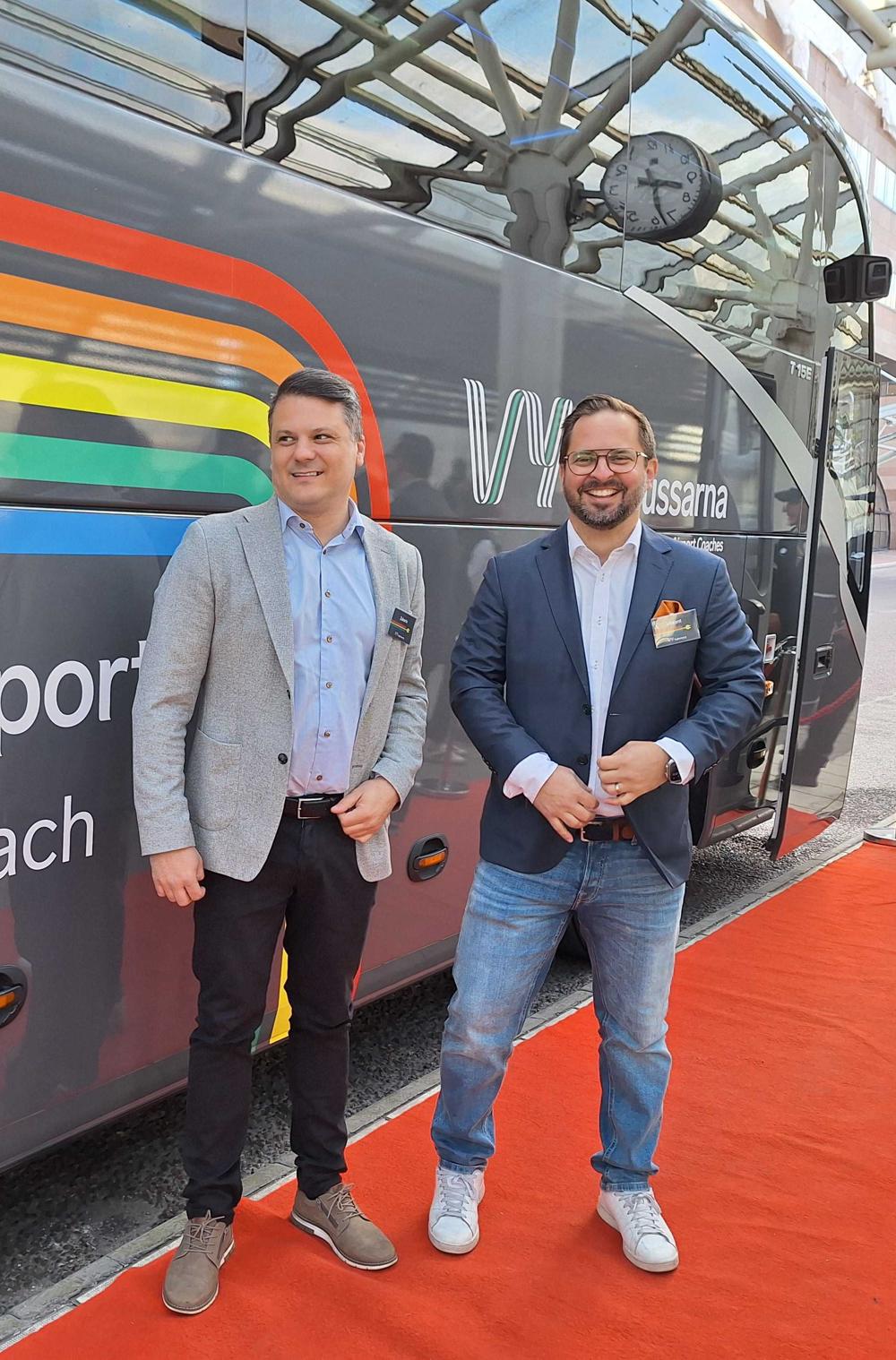There’s an intense race underway for electric Class III coaches, a race where Chinese manufacturers appear to be the clear frontrunners. Europe is painfully lagging behind in technical development, although it is slowly starting to catch up.
Among Chinese bus makers, Yutong is by far the largest, closely followed by BYD and King Long. Yutong’s factory, located in Zhengzhou in central China, is also one of the largest in the world — with 100 buses rolling off the production line daily.

Given this, choosing Yutong for Vy Flygbussarna’s pilot study was perhaps an easy decision. Another plus is that many Yutong buses are already operating in Norway and have been tried and tested — by Vy itself, the state owned bus company of Norway.
The bus will not be isolated from normal traffic to Arlanda; it will run within the regular timetable. A full charge will cover six round trips. Main charging will happen overnight at the depot, with a midday top-up at the same site before the bus heads back out.
In May, the Arlanda investigation is also expected to present a proposal to the Swedish government, one that includes creating dedicated public transport lanes all the way to the airport. If approved, travel time would be reduced to around 35 minutes.
Zakaria Abna-Aissa, head of commercial traffic at Vy, tells RT-Forum why the time is right to invest now.
– The technology is available. Electric city buses have been around for a while, but now manufacturers are ensuring it’s available for long-distance as well. Aviation is also facing a green transition, and we want to contribute to that.
More about the electric bus line Cityterminalen – Arlanda Airport
Start: Monday, May 12, 2025
Period: May – October 2025
Operation: 100% electric, fast charging
Bus model: Yutong T15E
Range: 600+ km, even in winter conditions
Safety features: EBS, ESP, LDWS
How will Vy Flygbussarna make the investment pay off if the company goes ahead?
– That’s exactly what we’re looking at now — the whole TCO (total cost of ownership) calculation. We’ll examine how much electricity it uses, what maintenance costs look like, and so on. It needs to be comfortable for our passengers, work well for our drivers, be logistically feasible with charging, and of course, be financially justifiable. After that, we’ll decide whether to scale up.
What obstacles do you foresee?
– Building the charging infrastructure. We’re in talks with Swedavia who owns Arlanda about needing chargers at Arlanda, but also here at Cityterminalen and with Jernhusen, who owns the building. Right now, we run in the morning until about 11–12, charge at the depot in Sollentuna, then head back out. It’s not as efficient as our other buses, but if we had charging at both ends, we’d get much more effective operations.




Why did Vy Flygbussarna choose Yutong?
– Partly because they’re big globally and well-tested — a lot of Yutong buses are sold worldwide. Vy also conducts audits at the factory in China and meets with Yutong’s suppliers. These are rigorous processes, and we set high standards for our suppliers to meet human rights and environmental requirements.
How do you think passengers will respond?
– Nowadays, Chinese cars and buses are fairly common, so I don’t think there will be much reaction. Passengers are more likely to notice how comfortable and pleasant it is to ride in an electric bus. That said, we will also be testing other brands.
Which brands?
– I’m holding off on commenting on that for now.
Buses manufactured in China often come with preconceived notions, largely due to various reports in recent years pointing to issues like forced labour and worker exploitation. For Yutong, the main concerns revolve around the batteries, which are supplied by CATL.
Joining the inaugural run was Anders Carnlöf, sales manager at Yes EU, the company that imports Yutong and also CRRC to the Swedish market.
– Our biggest challenge is reversing the negative perception of China-made products. We’re doing what we can — right now, we have people on site at the factory in China. With about 100 buses rolling off the line daily, it would be impossible to suddenly shift production for an unannounced audit, simply due to the sheer production volume.
Anders notes that the most recent audit, a so-called SMETA audit required by Swedish authorities, was conducted earlier this year.
– We demand these from CATL and from the factory in Zhengzhou. The report shows any discrepancies, and I’d say the only real remark was occasional overtime work at one of the factories. They’ve established an action plan.
Another obvious challenge is the negative attitude toward buses made in China. How will you turn that around?
– That’s a great question, Anders says, pausing before continuing:
– We don’t quite agree with the general perception. Our view isn’t the same as others when it comes to Chinese-made products. I’d say the production is highly structured — it’s organized, orderly, and not rushed.
In terms of price, the bus costs roughly double that of a traditional diesel coach. On top of that, there’s about a 10 % import fee to bring it into Sweden.
How long is the delivery time?
– Short. The bus itself takes a few weeks to build, but after ordering, it can be ready from the factory in about six months — about 8–9 months for a city bus. We usually say we can deliver within a year.





